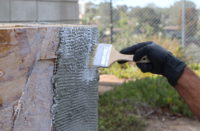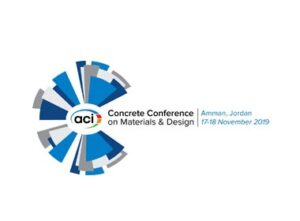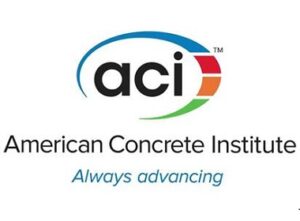
Many years in the making and rigorously reviewed by dozens of experts in the field, the much-anticipated 310R-13 Guide to Decorative Concrete was officially published by the American Concrete Institute in December 2013.
“It’s the most comprehensive guide of its kind,” says Larry Rowland, manager of marketing and technical services for Lehigh White Cement Co. and chair of ACI Committee 310, which, along with ACI staff, produced the 45-page document. “Its main purpose is to give guidance in nonmandatory language to designers and applicators about the materials and methods required to produce decorative concrete flatwork.”
Todd Scharich, a committee member and the decorative concrete specialist for the American Society of Concrete Contractors, sees it as a great reference tool from ACI, one of the industry’s leading authorities on concrete. “In my role as a specialist at ASCC, I get emails from architects and engineers from all over. Some have clear ideas of what they want but they are not sure how to get there. Before this, I didn’t have a resource to help them. This is the book for that.”
Prior to this landmark publication, Rowland notes, decorative concrete educational materials created by those in the industry largely dealt with different suppliers’ proprietary systems. “There was no generic guide that applicators or designers could use that didn’t hinge on one or more of those proprietary systems,” he says.
One of the neat things about this guide, he continues, is that it rolls the knowledge and experience gained by applicators, designers and experts in the field into one collective document that covers the most popular types of decorative concrete finishes.

An introduction to the guide
The ACI 310 guide defines and outlines how to best achieve most common decorative concrete finishes, including coloring, texturing and polishing. The document sums it up this way:
“This guide describes techniques for imparting aesthetic finishes to concrete flatwork, of which many can be combined for unique effects. The designer/engineer will acquire detailed, practical guidance for achieving aesthetic effects using proven techniques. Recommendations are made for the production of cast-in-place decorative concrete flatwork, decorative stains and overlays. In addition to attention to the specified materials, mixture designs, concrete placement, curing, protection, sealing and other treatments, this guide also considers the effects of these treatments on the overall aesthetics of the facility.”
The book is divided into 10 chapters: an introduction, definitions of terms, general and design considerations, plastic concrete coloring techniques, plastic concrete texturing and patterning techniques, post-placement coloring techniques, post-placement texturing and patterning techniques, decorative overlay and repair methods, maintenance and references.
“The document sequentially follows the process of producing decorative concrete flatwork from mix design to initial finishing, as well as post-placement procedures when you can come back later and do amazing things with even a standard slab to make it look great,” Rowland says. “It is also intended to assist designers in developing project specifications.”
History of a landmark
The concept for the guide began several years ago when Michael S. Smith, consultant and owner of Concrete Artisans LLC, in Broomall, Pa., petitioned the ACI to start a decorative concrete committee. An educational guide was desperately needed, Smith says, because many concrete contractors and architects didn’t fully grasp the decorative medium’s multidisciplinary uses.
“Architects weren’t sure what to specify to get the results the owners wanted,” Smith says, and specifications were often inconsistent and incomplete.
Some contractors, in turn, threw out large pricing estimates to cover the work they might be required to do. Others were lowballing their estimates to win jobs. The latter’s ensuing handiwork was muddying decorative concrete’s reputation, Smith says. “Contractors not well-versed in decorative concrete were getting into it not knowing what they were doing and producing short-term products that in the long term would not hold up.”
Consequently, owners became disillusioned with decorative concrete because they couldn’t afford what they wanted or didn’t get what they ordered, Smith says. A guide could alleviate these problems, he asserts.
ACI supported Smith’s idea, and at the fall 2007 ACI convention in Puerto Rico, the committee met for the first time, with Smith in the chairman’s seat.
“He took information from the ACI 303 flatwork guide and some other sources and wrote a preliminary document that served as the framework for this guide,” says Rowland, who was initially secretary of the committee but took over the helm in 2012 when Smith had to take a leave of absence. “He was the driving force to form the committee and pushed hard on this document’s success.”

Support from contractors
Currently, Rowland says, there are nearly 30 members on the ACI 310 committee, which comprises contractors, material suppliers, design experts and educators.
One of the committee’s younger members, Cori Sutton, says she came on board two years ago when the guide was already a work in progress. When she first started polishing floors in 2010, there was a lot of misunderstanding within the industry because, among other things, there was no common terminology among polishers. There also was no established method to accurately measure gloss levels. “I was shocked when I realized the industry wasn’t there yet,” says Sutton, president of Diamond Designer Concrete Inc., in Erie, Pa. When disputes arose, “we had nowhere to turn for answers. We had to deal with problems on our own.”
When she heard that ACI was working on a decorative guide that incorporated polishing, she jumped at the chance to join the committee and soon was appointed vice chair.
Another committee member, James Vermillion, master artisan at Concrete Polishing & Artistic Staining of Alaska, in Chugiak, got involved because he thought there was a lot of confusion in the design community as to what constituted polished concrete. “A whole bunch of people were saying they were doing polished concrete when they were only doing a partial grind without polishing, then applying a glossy clear coating.”
This type of floor behaves differently and is less durable, Vermillion points out, and owners didn’t know the difference until it failed six months down the road. “They weren’t happy about that, and that hurt the community,” he says.
“The guide gives the specifying and design community a standardized vocabulary,” Vermillion says. “It accurately describes decorative concrete so we can give owners what they envision.”
Scharich with the ASCC says he thinks the guide presents architects and engineers with a clear picture of what products are and aren’t capable of doing. “I hope the guide exposes architects to stuff they were unaware of and helps them understand and define products so they can be installed properly by qualified people.”
“Every contractor who is serious about their business should own a copy of this guide,” says former committee member and well-respected freelance writer Joe Nasvik, who now serves as a consultant to the committee when needed. “It defines best practice, and if a situation goes legal, the ACI guidelines could be used as expert testimony for either side.”
“This document will become the foundation for all future work in decorative concrete as it is added to and improved upon,” Rowland says. “I expect people to refer to this guide for decades.”
And members of the 310 committee point to Rowland for the successful fruition of the guide.
“If there is one hero in this whole thing,” Nasvik says, “it’s Larry Rowland. He has spent a lot of time on following through with developing documents and keeping the guide moving forward. If it weren’t for him, there wouldn’t be a document right now. It would still be a few years away.”
Now that the guide is out there, Smith says, “The committee’s next job is to dive into each chapter and get specific about what can and can’t be done, what you should and shouldn’t do.”
The 45-page guide — available as a hard copy or PDF, as well as in ePub or Kindle format — may be purchased from the ACI store at Concrete.org or through Amazon and Apple.















